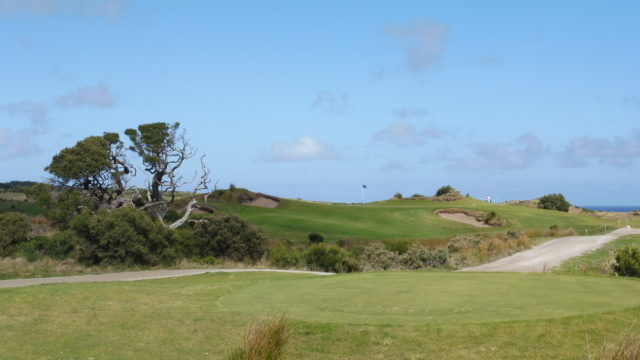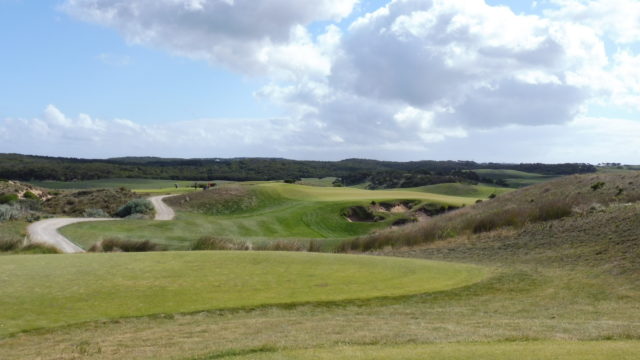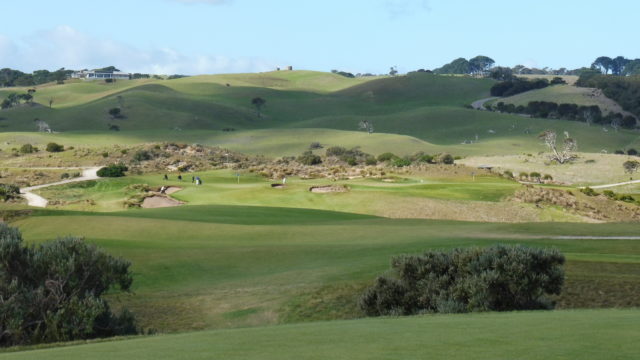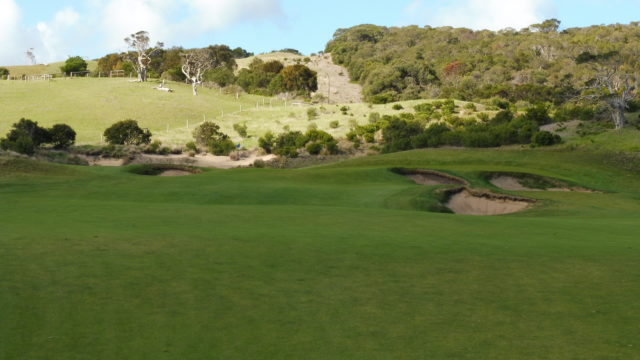
Location: Cape Schank, VIC
Established: 2000
Architect: Greg Norman & Bob Harrison
First Played: 17th Apr 2016
Last Played: 12th Jan 2023
Magazine Ratings

11 (Current)

12 (Current)
My third round of the April conquest, took me back to The National Golf Club, playing my 75th course (again) of the Top 100 Golf Course list. Oddly enough, my first time reaching 75 was playing the sister Ocean course. Today’s game would be on the Moonah course, catching up with an old pal, Harry, who I met, much earlier in the quest. My regular playing partner James was also along for the ride. This would also see the completion of all the courses at The National Golf Club.

Entrance to The National Golf Club
Driving in the gate you see the rolling hills and farmland, questioning whether there is a golf course anywhere on the grounds. The further you go in you start seeing glimpses of the course and some of the luxury residential properties on the course, although these are minimal and do not impede on the course at all. Finally you arrive to the grand clubhouse, which has quite a bit of memorabilia from some of the tournaments held and the outstanding practice facilities available, which even rival those at Augusta National (well maybe exaggerated but they are still good).

The Clubhouse overlooks the Ocean Gunnamatta Course 18th green
The National Golf Club was first launched during the Australian Masters tournament at Huntingdale Golf Club in 1985 as an equity shareholding. It was the first new club in Melbourne in 60 years. By 1988 the Robert Trent Jones Jnr designed links style course had been completed, known now as the Old Course.

Map of the Moonah Course at The National Golf Club
In 1996 the Club had acquired adjoining property, land which was spectacular to create a natural links course amongst the sand dunes along the coastline. This lead to two further courses being created, the Moonah Course designed by Greg Norman and Bob Harrison and the Ocean course, designed by Thomson, Wolveridge and Perrot, both of which were opened in 2000. The creation of the later two courses lead to a new clubhouse being built and re-routing of The Old course. In 2019 the Ocean course underwent a rebuild by Tom Doak, with repositioning of greens and re-routing of some holes. This then became the Gunnamatta course.

Moonah Course Scorecard at The National Golf Club
The Moonah course has been previously voted at the best that The National Golf Club had to offier. This changed in 2016 with the Old course placing one ahead on the Australian Golf Digest ranking, whilst also seeing the Old course joining the Top 100 of the World rankings.

Hole 1 – 340 meter par 4
Starting the round is this nice mid length par 4. Playing from an elevated tee, we can see the adventure that is about to begin over the rolling hills. The first is deceptive, with a large dune to the left, blocking half of the landing area. However everything beyond this makes its way in that direction.

Large sloping 1st fairway
Managing to carry the first rise in the fairway will allow the ball to run closer to the hole. Already we see some of the awkward lies that will be seen, with significant slope on the fairway. The first thing I was told by Harry, don’t hit the green unless you get a lot of zip on the ball. I of course didn’t fully listen, landing at the very front portion, but quite surprised to see the ball run right over the back. The green is not the longest but lesson learned. However James didn’t heed the warning until frustration got the better of him after the first nine. There is quite a bit of short grass on the surrounds of the green, but some of the rough grows down the slope, leaving a difficult chip, back up if long. Good hole to start the round and introduction to the Moonah course.

Hole 2 – 459 meter par 5
Lesson two for the day, there are many objects that will block views and deceive, like bunkers, dunes, hills. Playing the second, requires a carry over a slight rise, just large enough to not show what is beyond. Bunkers are either side of the fairway, but staggered. Hitting over the left hand side is the ideal, unless you just decide to hit it straight up the middle. Playing this hole down wind, made it quite short, along with the firm fairways seeing quite a bit of run.

Medium sloping 2nd green
This hole is relatively flat compared to most others on the course. It also sits at the base of large dunes running the entire length down the left. The fairway turns right and narrows greatly approaching the hole. So here you have a decision in whether to attack the green or lay up short of the narrow neck leading in. Lesson three and four for the day, laying up is not a bad option and check the entire green for its joys. With medium undulations and slopes, as well as hidden hollows, you may find the ball feeding away to areas you did not anticipate. This photo is a great demonstration on some of the intricacies in the green designs, which were very impressive and we were only on hole 2. Not a difficult par 5, but certainly enjoyable with a few decisions to make on each shot.

Hole 3 – 365 meter par 4
Heading back towards the clubhouse, is this mid length par 4, with a slight turn left. The tee shot requires some thought, as a spine runs diagonally through the middle. Failing to carry will see the ball run away to the right into a collection area. This also potentially leaves a long, blind shot to the green. Finding the fairway and carrying the spine is the only way to see the green for the approach.

Undulating 3rd fairway
The green is quite long with two tiers, but flat at the front, allowing an approach to run on. Landing in the wrong portion will leave a difficult putt, especially when short. The grain of the green run towards the front and slopes quite a lot from left to right. I was particularly interesting in watching one of the group putt from the front to the rear pin. Would have been tempting to chip the ball due to the slope. It couldn’t be hit hard enough to reach and found its way a lot further right than I imagined. Three holes and still impressing.

Hole 4 – 375 meter par 4
Another elevated tee on this medium-long par 4. At one of the higher points on the course, the view was terrific, especially of the hole we were about to play. The undulations in the fairway rolling on towards the green. Large sandy waste areas and a few bunkers. For long hitters carrying the mound to the right will see the hole shorten significantly. Great risk with a large sandy waste area slightly right of this but huge reward gaining distance and a better line into the green.

Uphill approach from the 4th fairway
Chances are the approach will be uphill, but the location on the fairway determines how much of a rise needs to be carried. Any shot on the left has bunkers in play with the approach. The bunkering doesn’t seem to be the typical Norman bunkers you experience at his other courses. Quite glad, as these seem to blend in very nicely with the environment.

Looking back at the 4th green
A good hole offering quite a bit in strategy and risk reward, in particular from the tee and how that lead into the approach.

Hole 5 – 145 meter par 3
The first par 3 for the day was a mid length hole. Sitting up on top of the ridge, overlooking the eastern side of the course, the green sits exposed to the wind. Framed by the Moonah tree short left, from here we have glimpses of the Tasman Sea. With an elevated green repelling anything short and bunkers either side, there is still some room allowed to miss right. Could be a very testing hole with strong cross winds. A hole well suited to its environment on the course.

Hole 6 – 349 meter par 4
Probably the first challenging tee shot for the day, requiring a 120 meter carry between over rough, before reaching the fairway. The left portion of the fairway is not seen, nor is the green. If you can find the left to center of the fairway, the approach will be much easier, with more of the green exposed.

Carry the divide to the 6th green
Longer drivers need to be cautious of running out of room on the fairway, before finding a large divide before the green. What presents itself though is a spectacular view of the green, with large bunkering built into the left side of the slope. The green is quite firm, but also long, joining the 14th green. I saw a few balls run through and down the rear slope. A challenging mid length par 4, especially if finding any of the hazards along the way. Is this the fairest of holes? Definitely not with a long carry to find the fairway being a big criticism. But very enjoyable for those that can.

Hole 7 – 482 meter par 5
A longer par 5 which snakes its way left and then right to the green. With a large fairway awaiting, the hill should be carried from the tee, but blocks out the landing area.

View of the 7th fairway
The fairway has various mounds, playing like a true links course. With the approach consideration must be made on whether to attack the green, which has a narrow entry point, or lay up to the wider fairway.

Looking back at the 7th green
A long putting surface angles away to the left, with part potentially hidden by a mound if left on the fairway. The longer holes had been very fair, but still offered some great challenges. Some deal of accuracy is required to get the best lines, but not too penal where shots still cannot be made to recover.

Hole 8 – 135 meter par 3
Ranked as the easiest par 3 and shortest hole on course, play is from an elevated tee to an elevated green. The green itself is quite wide but not deep.

Bunker complex protecting the 8th green
Various areas of rough and a small bunker complex protect the surrounds of the green. The putting surface itself has multiple tiers and significant slopes. Plenty of room is available to miss short, but leave a tricky pitch. A lot of pin positions available, some being a lot tougher than others, but great to play.

Hole 9 – 289 meter par 4
The shortest par 4 and easiest hole on the course, I always laugh when these are the holes that cause the most issues. Only part of the fairway can be seen between two dunes either side, short of the landing area. Another lesson, always great to play a holes twice to learn the best lines, although I already knew that.

Undulating 9th Fairway
The landing area is quite large, once beyond the dunes. You then face the undulations found on the fairway, which almost look like rough seas rolling in. There is some good use of sandy waste to the right of the fairway, where a slight turn occurs towards the green. Those playing too long and straight will come to rest here. Bunkers built into the left face of the green, will make pins on that side a bit more difficult. If laying up right , the green is partially blocked by another mound. There is a little bit going on with this hole, but offers the challenge of going at the green, but paying the price if not accurate.


Hole marker and pin flag
The Moonah course has a traditional style tee plate, whilst the colour of flag differs from the other courses. Great way to ensure you are heading towards the correct green. With one continuous loop, rather than two, there is a beverage cart which makes its way around the course, with facilities at various stages also.

Hole 10 – 356 meter par 4
Starting the back nine, is a mid length par 4, with a slight turn to the left. A windmill, showing the course origin of being farming land, was working until three years ago. Depending on your shot shape, it may come into play (although not sure on what the local rule was for this). A slight rise is found beyond this, before finding a downslope to the green.

The 10th fairway sloping down to the green
Playing this hole is like walking through a shallow valley, with dunes running either side of the fairway. We had a right hand pin position, probably the hardest to reach on all the green.

Sheltered 10th green
The design is almost a punch bowl, with most sides raised around the complex. Enjoyable hole to play, taking in the windmill, but more so the design of the hole and green complex.

Hole 11 – 334 meter par 4
A shorter par 4 follows, with a blind tee shot over a hill. Sandy waste is seen to the right, but not much of the fairway is visible, or the line to the green.

View of the 11th green complex
Before the green complex is a large hollow, with bunkers either side of the fairway. Ideally landing short of this, allows a view of where to play the ball. Playing from the bottom of the hollow leaves a blind shot.

Gently sloping 11th green
One thing that really impressed me throughout the course, was the design of the putting surfaces. The contouring and slopes, ensured lines of play from the fairway had to be considered. Landing in the correct portion of the green or playing the appropriate shot were also critical. Taking a slightly wrong line or speed into the green could see the ball end up in a totally different area than expected.

Hole 12 – 510 meter par 5
I was told the course doesn’t really start until the 12th. The longest hole on the course. For one in our group that proved to be true, whilst the others actually started to get their game together. Another blind tee shot over a large dune, but this time there is a line indicator displayed. A wide fairway is available to land the ball, but this changes as you progress.

View from the 12th Fairway
This hole really is about length. Finding your self out of position with your approach around the right turn of the hole, could mean taking on larger risk. A rise is found with a narrow fairway up to the green, containing bunkers to the right and waste to the left. It is not the most difficult of the long holes, with quite a wide fairway most of the way. The tricky part is in navigating the approach to the green.

Hole 13 – 159 meter par 3
Heading back up to higher land, this mi length par 3 has the putting surface totally hidden. If not for the flag, you would be guessing where the green is. A couple of bunkers in front help with the direction, but the dunes totally cover the width available.

Looking back at the 13th green
The green is quite open after getting past the raised bunkers, with quite a bit of area left of the putting surface to miss. Tricky par 3 due to the fact you can’t see the landing area, so taking the wrong line is a strong possibility.

Hole 14 – 420 meter par 4
At 420 meters you would think this is the longest par 4 on the course and a monster at that. The landing area is a large plateau sloping towards the hole, but on each side the fairway falls away as well. Into a strong headwind will require two great shots to reach the green. Finding one of the fairway bunkers will ensure that is impossible.

Play up a slope to the 14th Green
The fairway ends suddenly and falls away, at about 150 meters to the hole, leaving a hill up a decent slope. Traps are located on either side leading into the green, although those on the right also serve the 6th hole.

Multi tiered 14th Green
The cascading tiers are a standout of the putting surface. The other is the fact that it joins the 6th, conceivably balls may run down from that hole. Certainly a challenging hole where the main strategy is hit long. For most this will play as a short par 5, although surprisingly the index is 5.

Hole 15 – 495 meter par 5
Almost feeling like two par 5 holes in a row, comes the hardest of the fives. Large undulations are found below the elevated tee. The fairway initially turns right, before a left leading up to the green. Risk and reward is offered with the second shot, carrying a large mound but cutting the corner to either reach or be slightly short of the green.

Uphill slope on the 15th fairway
Playing the traditional route, the approach is up a slope to an elevated green. A cluster of traps are located right, with one sitting left (which James managed to hole out from). The putting surface was quite wide, with a large hollow found at the front. Landing on the wrong portion can therefore leave an almost impossible putt. Quite enjoyable hole, allowing some risks to be taken, in trying to reach the green in few shots. Certainly allows for a variety of ways to play, challenging all levels of player.

Hole 16 – 422 meter par 4
So now we did reach the longest par 4, also the hardest hole on the Moonah course. Logically a wide fairway is available. From the elevated tee you carry a lower area before the fairway rises again, with bunkers staggered on either side. Just beyond this is a large fall away, which if playing downwind could be reached, shortening the hole by 30-40 meters.

Well defended 16th green
In most cases a long shot will be required to reach the green, or more realistically the area short of it. Four traps are located left, with the slope feeding down to these. The putting surface has two tiers, with the rear slightly raised. Really felt like playing three par five holes in a row. I had actually played both the long par four holes well, but must admit I didn’t find them any where near as enjoyable as a lot of the mid length par fours. They felt like more of a slog, where bogey felt like a real achievement. They were designed well for what they were and if playing down wind would probably be much easier. Having two so close together on the scorecard was also not what I would call ideal.

Hole 17 – 170 meter par 3
The penultimate hole, is the longest and hardest par 3. Other than distance the hole looks fairly flat, but was a standout with the trees as part of the background. Fairway slopes to the right, with a swale in this direction being a good collection area near the green. The right is a lot more open than the left.

Moonah tress beside the 17th green
With the ground sloping towards the green from the left, this is not the place to miss. One of the more relaxed par three holes on the course, where distance is the main defence. Good use contours will see a variety of shots around the green.

Hole 18 – 387 meter par 4
Leading back to the clubhouse, the last hole again has obstructions to assist in deceiving how the fairway lays. Balls heading to the right may not be found within the dense scrub. This hole plays relatively straight, but a large mound to the left will stop most balls from progressing far down the fairway.

Tree lined 18th fairway
Unusually, for this course anyway, a few trees are scattered every so often at the fairway edge. The last two holes had a totally different feel to the rest of the course. I’m not sure if that was due to the number of trees in proximity, or that they didn’t have the same look as the dunes and sandy waste.

A last look back from the 18th green
The long narrow green has a bunker at its front to carry, although it can be navigated to its left. This wasn’t a standout hole for me, as mentioned, it felt quite different to the rest of the course.
In summary the Moonah course was well deserved in being ranked so highly. This challenged my thoughts at being one of the best courses I had played, my original decision of the sister Old course still stands. The routing utilised some great land, providing a range of holes varying in elevation, whilst incorporating a great natural feel of a links courses, with undulations throughout the fairways, rolling along like the sea.
Looking at the course makeup:
- Hole Directions – There was a huge variety allowing for conditions to have wide ranging effects during play. Directions faced were all over the compass. Thought has been given to ensure hitting into the morning or afternoon sun is avoided.
- Hole Lengths – Par three holes had the lease variance in distance, all being mid length. Par four holes ranged from short to long with the mid and long making up the majority. Par 5 holes ranged from medium to long, with the later having the majority
- Hole Layout – There was an even split in how the holes played, left, right or straight, where two shots or more were required to reach the green
The fairways remained firm, allowing some run of the ball, but I’m not sure on whether the greens were very receptive. I can generate quite a bit of spin, but saw my first approach run totally through the green. From that point I tried to ensure the ball was run into the green more often than not.
Mostly the holes were fair to all levels of play, but there were a couple of standouts which required a significant carry to reach the fairway.
But it was the green complexes themselves which were a delight. The use of varying undulations, swales, and slopes throughout, made you think greatly about each shot. It was amazing to see how the ball would travel to unexpected areas, if some observations from various angles was not carried out.
A course I eagerly await to return and play again.

Selfie of James and I on the 18th green
How to play at The National Golf Club Moonah Course:
1. Be invited by a member
2. Be an interstate or overseas visitor who is a member of a golf club
3. Look on social golf club websites for events at the course
I was invited by a member to play the course.

